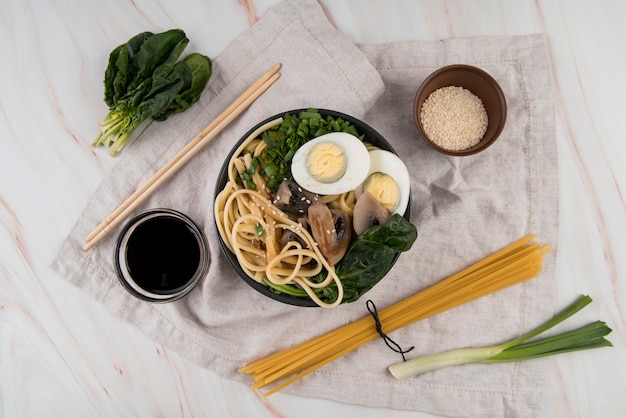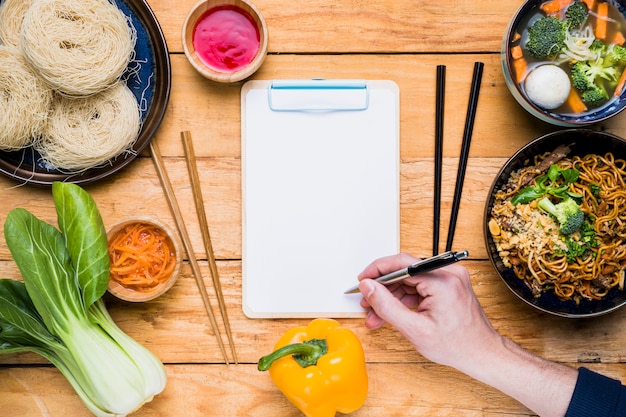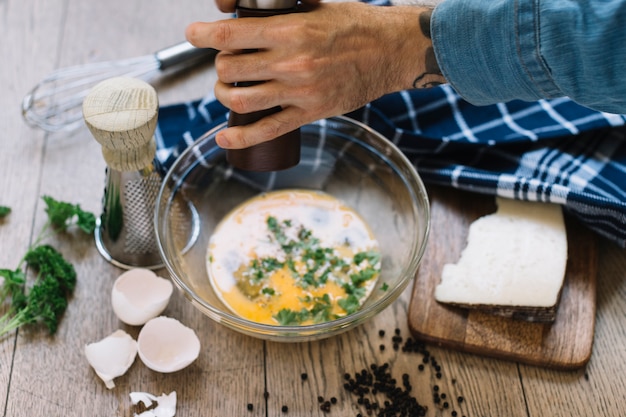Let's be honest, ramen is the ultimate comfort food, a warm hug in a bowl. But ramen isn't just about the noodles, is it? It's about the broth, the toppings, the whole shebang. And for me, no ramen experience is complete without the glorious crunch of perfectly cooked bok choy.
This isn't just a recipe. It's a love story, a journey through the world of bok choy and its glorious marriage with ramen. So, grab a cuppa, settle in, and let's get cookin'.
(Part 1) Why Bok Choy Belongs in Your Ramen Bowl

Let's be real, bok choy isn't just a pretty face in the ramen bowl, it's the real deal, the MVP. This veggie adds texture, flavour, and a whole lot of nutrients to the party. It's a nutritional powerhouse, bursting with vitamins, minerals, and antioxidants. So, you're not just getting a delicious bowl of ramen, you're getting a dose of health goodness too!
1.1 The Textural Delight
I love how bok choy adds that perfect crunch to my ramen. It's like the little pop of texture that wakes up your taste buds, making every mouthful a delightful surprise. The contrast between the soft noodles and the crisp bok choy is just…well, it's a taste sensation, really.
I remember the first time I tried bok choy in ramen. I was at a tiny, hole-in-the-wall ramen shop in Tokyo, and the owner, a kindly old man with a twinkle in his eye, recommended it. I was hesitant at first, but I took a bite and was blown away. The crunchy texture was a revelation, a playful counterpoint to the smooth noodles.
1.2 The Flavour Explosion
Don't even get me started on the flavour! Bok choy has this lovely, subtle sweetness that blends beautifully with the salty broth and the umami flavour of the noodles. And, depending on how you cook it, you can get different levels of intensity, from a delicate, almost sweet flavour to a slightly bitter, more intense taste. It's all about finding your perfect balance.
For example, if you're using a lighter, shoyu-based broth, a gentle blanching will bring out the sweetness of the bok choy. But if you're going for a bolder, miso broth, you might want to give the bok choy a quick stir-fry with some garlic and ginger to add a more robust flavour.
1.3 The Health Factor
Right, so, we've got the crunch, we've got the flavour, but here's the clincher: bok choy is a nutritional superstar. Packed with vitamins A, C, and K, it also boasts a decent amount of fiber, which is great for digestion. So, you're not just indulging, you're actually doing something good for yourself!
Bok choy is also a good source of antioxidants, which can help protect your body from damage caused by free radicals. So, not only does it make your ramen taste amazing, but it can also contribute to a healthier you.
(Part 2) Choosing the Right Bok Choy

Now, you can't just grab any old bok choy and throw it in your ramen. You need to choose the right one, the one that will make your ramen sing.
2.1 A Little Bok Choy Know-How
First things first, you've got to know your bok choy. There are two main types: baby bok choy and mature bok choy. Baby bok choy is smaller, sweeter, and has more tender leaves. Mature bok choy, on the other hand, has thicker stems and leaves, and a more robust flavour.
Think of baby bok choy as the delicate ballerina of the bok choy world, while mature bok choy is the powerful, seasoned dancer.
2.2 Picking the Perfect Piece
Look for bok choy with vibrant green leaves that are firm and crisp. Avoid any that have wilted leaves, yellowing, or brown spots.
When you're in the supermarket, give the bok choy a gentle squeeze. It should feel firm and springy, not soft or mushy. If the leaves are wilted or discolored, it's best to choose another one.
(Part 3) Prepping Your Bok Choy for Ramen Glory

Alright, you've got your perfect bok choy. Now, let's get it ready for its close-up.
3.1 A Clean Slate
Start by rinsing your bok choy under cool running water to wash away any dirt or debris. Then, give it a good shake to remove excess water.
It's important to get rid of any dirt or grit, as it can affect the taste and texture of your bok choy.
3.2 Cutting It Up
Next, you need to cut the bok choy into bite-sized pieces. You can slice it thinly, chop it roughly, or even tear it apart with your hands. I find that slicing it thinly gives you the best bite-to-broth ratio, but it's all about personal preference, really.
The way you cut your bok choy will affect how it cooks and how it interacts with the broth. Thin slices cook quickly and absorb the broth more readily, while thicker pieces maintain their crunch and add a more substantial texture to your ramen.
3.3 The Secret Weapon
Now, here's a little tip: separate the leaves from the stems. The leaves will cook faster, so you'll want to add those later in the game. The stems, though, need a little more time to soften up.
This step is essential for ensuring that both the leaves and stems are cooked to perfection. The leaves will be tender and wilted if cooked for too long, while the stems will be tough and unyielding if not cooked long enough.
(Part 4) Cooking Bok Choy for Ramen: The Techniques
Time to get your hands dirty! This is where the magic happens, the transformation of bok choy into a ramen-worthy masterpiece.
4.1 The Blanching Method
This is my go-to method because it's quick, easy, and ensures a perfectly crisp texture. Fill a pot with water, bring it to a boil, add some salt, and then drop your bok choy stems in. Cook for about 30 seconds to a minute, until they're slightly tender but still retain their crunch. Remove the stems with a slotted spoon and plunge them into a bowl of ice water to stop the cooking process.
Blanching is a classic technique that quickly cooks vegetables while preserving their vibrant colour and crisp texture. The ice bath helps to shock the bok choy, stopping the cooking process and preventing it from becoming overcooked.
4.2 The Stir-Fry Method
This method is great for adding some extra flavour to your bok choy. Heat some oil in a wok or pan, add your stems and cook for a couple of minutes, stirring occasionally, until they're softened and slightly browned. Add a splash of soy sauce or oyster sauce for extra flavour, and you're good to go.
The stir-fry method allows you to quickly cook the bok choy while adding a depth of flavour. You can also use a variety of spices and sauces, such as garlic, ginger, chili flakes, or sesame oil, to create unique flavour profiles.
4.3 The Slow-Cook Method
If you want a softer, more tender bok choy, you can add it to your ramen broth while it's simmering. This allows the flavours of the broth to infuse into the bok choy, creating a delicious, umami-rich experience.
This method is great for those who prefer a more delicate bok choy with a softer texture. The slow-cooking process allows the bok choy to absorb the rich flavours of the broth, creating a harmonious blend of tastes.
(Part 5) Adding Bok Choy to Your Ramen
You've got your cooked bok choy, you've got your perfect bowl of ramen. Now, let's bring it all together.
5.1 The Timing is Everything
For the blanched or stir-fried bok choy, add it to your ramen bowl just before serving. This ensures it stays crisp and delicious. If you're using the slow-cooked method, you can add the bok choy to your broth about 10 minutes before you're ready to serve.
Timing is crucial for achieving the perfect texture and flavour. Adding the bok choy too early will result in wilting leaves, while adding it too late will leave it undercooked.
5.2 The Finishing Touches
Once you've added your bok choy, give your ramen a good stir. You can also add some other toppings, like a soft-boiled egg, a sprinkle of green onions, or a dollop of sesame oil, to round out the flavour profile.
The toppings you choose can make all the difference in the flavour and presentation of your ramen. Experiment with different combinations and find your own perfect balance of textures and tastes.
(Part 6) ramen recipes with Bok Choy: Get Inspired
Now, I know you're probably thinking, "Great, I can cook bok choy for ramen, but what recipes can I make?" Well, hold onto your chopsticks, because I'm about to share some of my favourite ramen recipes that showcase the magic of bok choy.
6.1 The Classic Shoyu Ramen with Bok Choy
This is a simple, yet delicious ramen that highlights the delicate flavours of both the broth and the bok choy.
Here's what you'll need:
1 tablespoon of vegetable oil
1/2 onion, sliced
2 cloves of garlic, minced
1 inch ginger, grated
1 cup chicken broth
1/2 cup soy sauce
1/4 cup mirin
1 teaspoon of sugar
1 pack of ramen noodles
1 cup blanched bok choy
Instructions:
1. Heat the oil in a pot and sauté the onion, garlic, and ginger until fragrant.
2. Add the chicken broth, soy sauce, mirin, and sugar. Bring to a boil, then reduce heat and simmer for 10 minutes.
3. Cook the ramen noodles according to package instructions.
4. Divide the noodles into bowls and top with the broth, cooked bok choy, and your favourite toppings.
This is a classic recipe that's perfect for beginners. It's simple to make but incredibly delicious.
6.2 The Spicy Miso Ramen with Bok Choy
This ramen packs a punch with its spicy miso broth and crunchy bok choy.
Here's what you'll need:
1 tablespoon of vegetable oil
1/2 onion, sliced
2 cloves of garlic, minced
1 inch ginger, grated
1 cup chicken broth
1/2 cup miso paste
1/4 cup chili oil
1/4 cup soy sauce
1 tablespoon of mirin
1 pack of ramen noodles
1 cup blanched bok choy
Instructions:
1. Heat the oil in a pot and sauté the onion, garlic, and ginger until fragrant.
2. Add the chicken broth, miso paste, chili oil, soy sauce, and mirin. Bring to a boil, then reduce heat and simmer for 10 minutes.
3. Cook the ramen noodles according to package instructions.
4. Divide the noodles into bowls and top with the broth, cooked bok choy, and your favourite toppings.
For those who like things a little spicier, this recipe is sure to hit the spot. The miso broth is rich and flavourful, while the chili oil adds a welcome kick.
6.3 The Creamy Vegan Ramen with Bok Choy
This ramen is a delicious vegetarian option that features a creamy, rich broth and fresh, crunchy bok choy.
Here's what you'll need:
1 tablespoon of vegetable oil
1/2 onion, sliced
2 cloves of garlic, minced
1 inch ginger, grated
4 cups vegetable broth
1/2 cup coconut milk
1/4 cup soy sauce
1 tablespoon of sesame oil
1 pack of ramen noodles
1 cup blanched bok choy
Instructions:
1. Heat the oil in a pot and sauté the onion, garlic, and ginger until fragrant.
2. Add the vegetable broth, coconut milk, soy sauce, and sesame oil. Bring to a boil, then reduce heat and simmer for 10 minutes.
3. Cook the ramen noodles according to package instructions.
4. Divide the noodles into bowls and top with the broth, cooked bok choy, and your favourite toppings.
This recipe is perfect for those who are looking for a vegan and healthy ramen option. The creamy coconut milk broth is both delicious and satisfying, while the bok choy adds a fresh and crunchy element.
(Part 7) Tips and Tricks for Cooking Bok Choy for Ramen
Alright, you're ready to cook. Now, let's go over some tips and tricks that will make your bok choy ramen game even stronger.
7.1 Don't Overcook it
Remember, you want your bok choy to be crisp and tender, not mushy. Overcooked bok choy loses its texture and flavour.
The key to perfect bok choy is to cook it just until it's tender-crisp. Overcooked bok choy will be wilted and limp, which won't add much to your ramen.
7.2 Season Your Broth
Seasoning your ramen broth is crucial for a delicious bowl of ramen. Use a combination of soy sauce, mirin, sugar, and other spices to create a balanced flavour profile.
The broth is the foundation of your ramen, so it's essential to get the seasoning right. Start with a base of soy sauce and mirin, and then add other spices and seasonings to your liking.
7.3 Experiment with Toppings
Don't be afraid to get creative with your toppings. There's a whole world of ramen toppings out there, from soft-boiled eggs to pickled ginger to seaweed.
Toppings can elevate your ramen to the next level. Try adding different ingredients, such as bean sprouts, mushrooms, tofu, or even a sprinkle of chili flakes for a spicy kick.
7.4 Don't Be Afraid to Adjust
This is your recipe, your kitchen. Feel free to adjust the amount of bok choy, the cooking time, or the seasoning to your own preferences.
Cooking is all about experimentation and finding what works best for you. Don't be afraid to try different techniques and adjust the recipe to suit your own taste buds.
(Part 8) FAQs: Your Bok Choy Ramen Questions Answered
Alright, now let's get to your burning questions about bok choy and ramen.
8.1 Can I substitute another vegetable for bok choy in my ramen?
Absolutely! If you don't have bok choy, you can use other leafy greens like spinach, kale, or even Napa cabbage.
While bok choy is a classic choice, other vegetables can also add a delicious and nutritious element to your ramen.
8.2 Can I cook the bok choy in the broth?
Yes, you can definitely cook the bok choy in the broth. If you're using the stems, add them to the broth about 10 minutes before you're ready to serve.
Cooking the bok choy in the broth allows its flavour to infuse into the broth, creating a more complex and satisfying taste.
8.3 How do I store bok choy?
Store bok choy in the refrigerator for up to a week. Wrap it in a damp paper towel and place it in a plastic bag.
Proper storage is essential for keeping your bok choy fresh and crisp. The damp paper towel will help to keep the bok choy hydrated.
8.4 Can I freeze bok choy?
You can freeze bok choy, but it's best to blanch it first. This helps to preserve its texture and flavour.
Blanching the bok choy before freezing will help to retain its vibrant colour and crisp texture.
8.5 What are some other ways to cook bok choy?
Besides ramen, you can enjoy bok choy in stir-fries, soups, salads, and even as a side dish. It's a versatile vegetable that can be cooked in many different ways.
Bok choy is a wonderful ingredient that can be used in a variety of dishes. Get creative and experiment with different cooking techniques to discover new ways to enjoy this delicious and nutritious vegetable.
(Part 9) The Final Word
Listen, cooking bok choy for ramen is an art form. It’s about finding the perfect balance of flavour, texture, and technique. It’s about experimenting, adjusting, and discovering what works best for you. So, get in the kitchen, grab some bok choy, and let your ramen journey begin!
Everyone is watching

Perfect Rice Every Time: The Ultimate Guide to Cooking Rice
Cooking TipsAs a self-proclaimed foodie, I've always been a bit obsessed with rice. It's the foundation of countless cuisi...

Prime Rib Roast Cooking Time Chart: Per Pound Guide
Cooking TipsPrime rib roast. Just the name conjures images of lavish dinners, crackling fires, and hearty laughter. It’s ...

The Ultimate Guide to Cooking Asparagus: Tips, Techniques, and Recipes
Cooking TipsAsparagus. The mere mention of this spring delicacy conjures up images of vibrant green spears, crisp and burs...

Ultimate Guide to Cooking the Perfect Thanksgiving Turkey
Cooking TipsThanksgiving. Just the word conjures up images of overflowing tables laden with delicious food, the scent of r...

How Long to Bake Potatoes in the Oven (Perfect Every Time)
Cooking TipsBaked potatoes are a staple in my kitchen. They're incredibly versatile, delicious, and surprisingly easy to m...
